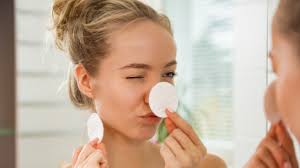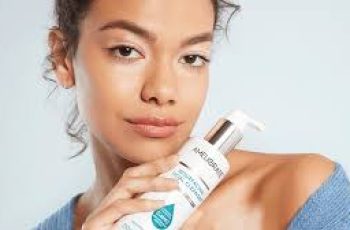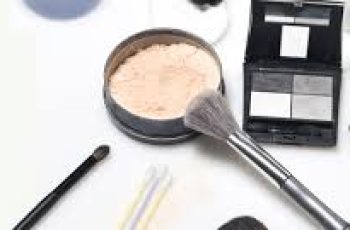
Should I Use Benzoyl Peroxide or Salicylic Acid First?
If you have suffered from severe breakouts before, you may already have a full understanding of what benzoyl peroxide and salicylic acid can do for the skin. But if all of this is new to you, then you’ve come to the right place as we are going to help shed a little light on both of these skincare ingredients and the best way of using them and when to use them in your daily regime.
Benzoyl Peroxide Vs Salicylic Acid- What is the main difference?
Both of these ingredients have an exceptional ability to help keep your skin clear of breakouts and blemishes, although it may feel as if they are targeting the same areas, benzoyl peroxide and salicylic acid vary in the ways they treat the skin and any active flareups you may be currently suffering from.
Salicylic acid helps to remove the build-up of dead skin cells that can clog pores which eventually leads to a spot or blackheads, whilst benzoyl peroxide will kill any bacteria that is also a culprit at creating pesky breakouts. Each ingredient is highly effective at treating acne and both are considered safe enough to use in conjunction with each other. For example, one evening you can use salicylic acid, and then benzoyl peroxide the following evening which is a a highly beneficial way of treating problematic skin. As always, we highly recommend seeking advice from your GP or dermatologist before using high concentration of these ingredients.
The habit of your breakouts and skin type have also got a part to play in the overall appearance of your complexion. If you find there are constant active spots and blackheads on your face then benzoyl peroxide would be the ideal ingredient to use. For more hormonal breakouts, salicylic acid will help you buff away the dead skin cells and keep on top of the clarity of the skin.
What is benzoyl peroxide?
Benzoyl peroxide, also known as BPO, is an over the counter skincare ingredient that has the ability to kill bacteria on your skin. It is available in a number of concentrations ranging from 2.5%, 5% and 10% allowing sufferers of moderate to severe acne to be treated. It also contains exfoliating properties that steadily increase the cell turnover of the skin by removing any dead skin cells whilst ridding the pores of any excess sebum too.
Once you have applied benzoyl peroxide to the skin, it will set to work at targeting all the lesions found on the skin from blackheads, whiteheads and active red pimples. Its ability to kill the bacteria and reduce the size of the breakouts in rapid time allows you to start noticing a difference in your skin after just five days. You can understand it’s popularity with its ability to deliver such impressive fast results. Be warned however, using the right amount of benzoyl peroxide is vital to keeping your skin looking its best as the wrong amount will result in some side effects, such as dryness, peeling and redness.
The skincare benefits of benzoyl peroxide
Benzoyl peroxide is able to kill any form of blemish causing bacteria
Benzoyl peroxide helps to increase the turnover of dead skin cells allowing the skin to become rejuvenated
Benzoyl peroxide is sold over the counter in varies strengths making it easier for many people to use by matching their skin type and concerns to the best percentage level
Benzoyl peroxide in fast-acting and will show results in 5 days
Side effects of using benzoyl peroxide
Benzoyl peroxide can cause dryness, redness and sometimes peeling to the skin
Benzoyl peroxide can cause bleaching if it comes into contact with dark fabrics
Benzoyl peroxide is known to cause post-inflammatory hyperpigmentation (dark spots and uneven skin tone)
What should you not use benzoyl peroxide with?
When using benzoyl peroxide for treating breakouts and blemishes its best to avoid using retinol at the same time as both these ingredients have similar effect on the skin which results in them cancelling each other, resulting in them both becoming a useless step in your skincare routine.
With benzoyl peroxide being quite a potent anti-blemish ingredient, the chances of it potentially causing dryness to the skin are high, this is why it is advisable to team this bacteria-fighting ingredient with products that are enriched with moisturising and hydrating ingredients, such as hyaluronic acid. Once you have locked moisture into the skin you must also remember to protect it from environmental stresses, the main one being UV rays. Applying a daily SPF is an important step in your routine when using benzoyl peroxide as the exfoliation can make the skin more sensitive to the sun, SPF of 30 and above will keep the skin safe from any damage.
What is salicylic acid?
Salicylic acid is a beta hydroxy acid, also known as BHA and is able to reach down into the lower layers of the skin. It can help treat acne and has the ability to exfoliate the skin and unclog the pores of any build-up of excess sebum, bacteria and left-over debris. Quite often you will find the skin suffers from a build-up of dead skin cells which is another contributing factor to blemishes. Salicylic acid is able to dissolve the bonds holding the dead skin cells to the top layer of the face, making dead skin cells easier to buff away and reveal the new vibrant skin underneath.
Much like benzoyl peroxide, salicylic acid is formulated into many over the counter products and comes in varying concentrates from 0.5%-2%. One of the main differences between the two ingredients is salicylic acid is able to combat blemishes whilst soothing the skin which makes this a unique benefit of salicylic acid compared to other spot fighting ingredients that are known to cause dryness, redness and irritation. You can find out more about this BHA in our blog post about the skincare benefits of salicylic acid.
The skincare benefits of salicylic acid
Salicylic acid exfoliates the skin by removing a build-up of dead skin cells
Salicylic acid is able to reduce the appearance of pores
Salicylic acid is able to sooth the skin and calm inflammation
Salicylic acid is a BHA and is able to work further down into the layers of the skin
Salicylic acid can deep clean the pores of any bacteria, excess sebum and debris that can clog pores
Side effects of using salicylic acid
Salicylic acid if used incorrectly can cause redness, blistering and a rash
Salicylic acid unlike benzoyl peroxide can take a number of weeks before showing any results
Benzoyl peroxide and salicylic acid are both highly powerful ingredient which can deliver results when combating problematic skin. It really doesn’t matter which ingredient you decide to use first, they both provide impressive benefits and help you keep your skin clear and combat any breakouts with ease. By adding these into a routine that contains a number of other powerful acne fighting ingredients you will really notice a difference in your complexion. To help you build a blemish-fighting routine you can check out our blog about which ingredients help clear acne for more information.
Don’t forget to join us on Instagram for daily skin care tips, product launches and exclusive discount codes. Don’t miss out on more skincare tips and expert advice over on our YouTube channel! Come and find us on The Green Sofa by hitting the subscribe button, you won’t regret it!


